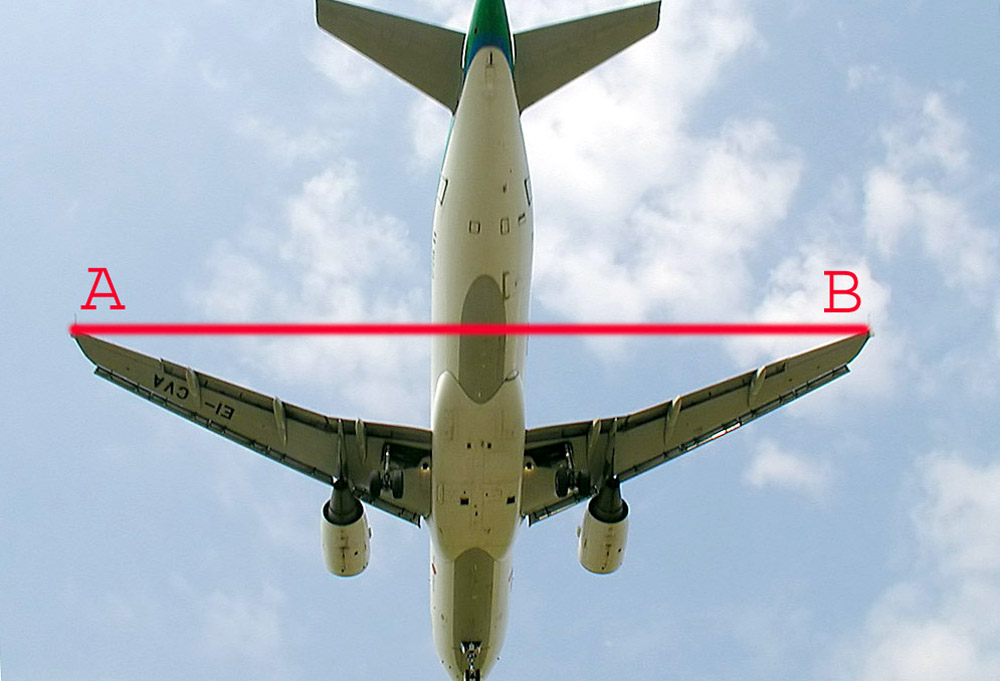| Admissions | Accreditation | Booksellers | Catalog | Colleges | Contact Us | Continents/States/Districts | Contracts | Distance Education | Emergency | Examinations | Forms | Grants | Hostels | Honorary Doctorate degree | Investment | Instructors | Lecture | Librarians | Membership | Professional Examinations | Programs | Progress Report | Recommendations | Research Grants | Researchers | Students login | School | Search | Seminar | Study Center/Centre | Sponsorship | Tutoring | Thesis | Universities | Work counseling |
 The distance A to B is the wingspan of this Aer Lingus Airbus A320. The wingspan (or just span) of an airplane or a bird, is the distance from one wingtip to the other wingtip. For example, the Boeing 777 has a wingspan of about 60 metres (197 ft); and a Wandering Albatross (Diomedea exulans) caught in 1965 had a wingspan of 3.63 metres (11 ft 11 in), the official record for a living bird. Wingspan of aircraft The wingspan of an aircraft is always measured in a straight line, from wingtip to wingtip, independently of wing shape or sweep. Implications for aircraft design and animal evolution The lift from wings is proportional to their area, so the heavier the animal or aircraft the bigger that area must be. The area is the product of the span times the width (mean chord) of the wing, so either a long, narrow wing or a shorter, broader wing will support the same mass. For efficient steady flight the ratio of span to chord, the aspect ratio, should be as high as possible (the constraints are usually structural) because this lowers the lift-induced drag associated with the inevitable wingtip vortices. Long-ranging birds, like albatrosses, and most commercial aircraft maximize aspect ratio. Alternatively, animals and aircraft which depend on maneuverability (fighters, predators, the predated and those who live amongst trees and bushes, insect catchers, etc.) need to be able to roll fast to turn, and the high moment of inertia of long narrow wings produces lower roll rates. For them, short-span, broad wings are preferred. The highest aspect ratio man-made wings are aircraft propellers, in their most extreme form as helicopter rotors. |
|
Chord (aircraft)
In aeronautics, chord refers to the imaginary straight line joining the trailing edge and the center of curvature of the leading edge of the cross-section of an airfoil. The chord length is the distance between the trailing edge and the point on the leading edge where the chord intersects the leading edge.[1] The wing, horizontal stabilizer, vertical stabilizer and propeller of an aircraft are all based on airfoil sections, and the term chord or chord length is also used to describe their width. The chord of a wing, stabilizer and propeller is determined by examining the planform and measuring the distance between leading and trailing edges in the direction of the airflow. (If a wing has a rectangular planform, rather than tapered or swept, then the chord is simply the width of the wing measured in the direction of airflow.) The term chord is also applied to the width of wing flaps, ailerons and rudder on an aircraft. The term is also applied to airfoils in gas turbine engines such as turbojet, turboprop, or turbofan engines for aircraft propulsion. Most wings do not have a rectangular planform so they have a different chord at different positions along their span. To give a characteristic figure which can be compared among various wing shapes, the mean aerodynamic chord, or MAC, is used. The MAC is somewhat more complex to calculate, because most wings vary in chord over the span, growing narrower towards the outer tips. This means that more lift is generated on the wider inner portions, and the MAC moves the point to measure the chord to take this into account. Standard mean chord Mean aerodynamic chord Tapered wing http://www.airfieldmodels.com/information_source/math_and_science_of_model_aircraft/formulas/mean_aerodynamic_chord.htm |
